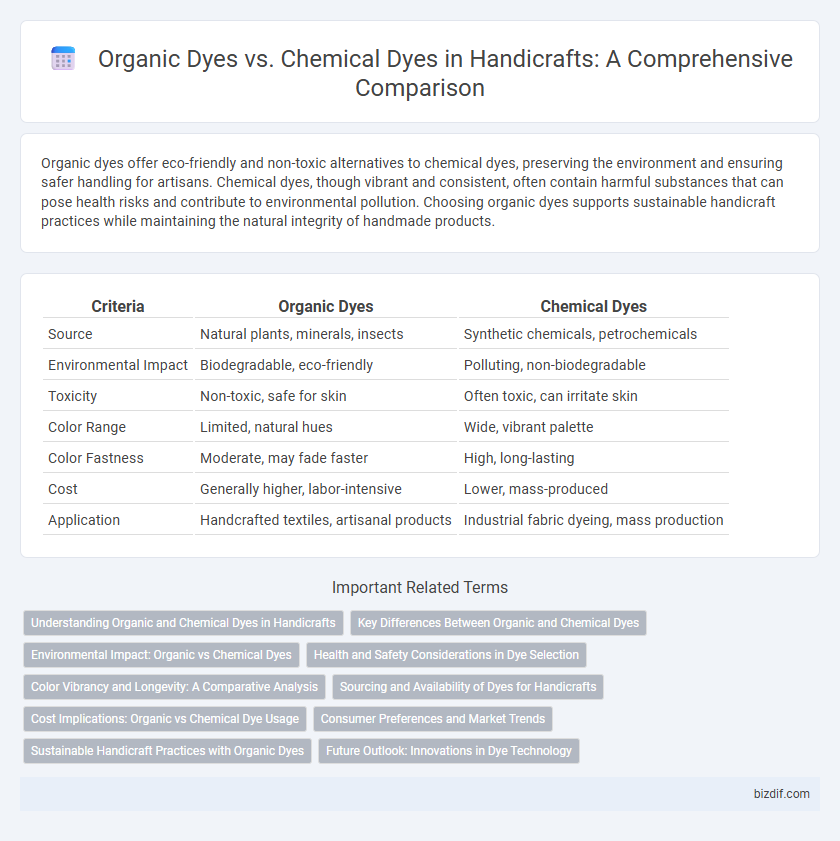Organic dyes offer eco-friendly and non-toxic alternatives to chemical dyes, preserving the environment and ensuring safer handling for artisans. Chemical dyes, though vibrant and consistent, often contain harmful substances that can pose health risks and contribute to environmental pollution. Choosing organic dyes supports sustainable handicraft practices while maintaining the natural integrity of handmade products.
Table of Comparison
| Criteria | Organic Dyes | Chemical Dyes |
|---|---|---|
| Source | Natural plants, minerals, insects | Synthetic chemicals, petrochemicals |
| Environmental Impact | Biodegradable, eco-friendly | Polluting, non-biodegradable |
| Toxicity | Non-toxic, safe for skin | Often toxic, can irritate skin |
| Color Range | Limited, natural hues | Wide, vibrant palette |
| Color Fastness | Moderate, may fade faster | High, long-lasting |
| Cost | Generally higher, labor-intensive | Lower, mass-produced |
| Application | Handcrafted textiles, artisanal products | Industrial fabric dyeing, mass production |
Understanding Organic and Chemical Dyes in Handicrafts
Organic dyes, derived from natural sources like plants, minerals, and insects, offer eco-friendly and biodegradable options for handicraft artisans, ensuring vibrant colors without harmful environmental impact. Chemical dyes, synthesized through industrial processes, provide a wider range of hues and greater colorfastness but often involve toxic substances that can affect both health and sustainability. Understanding the properties, benefits, and drawbacks of organic versus chemical dyes enables craftsmen to make informed choices that balance aesthetic quality with environmental responsibility.
Key Differences Between Organic and Chemical Dyes
Organic dyes are derived from natural sources such as plants, insects, and minerals, offering eco-friendly and biodegradable alternatives with lower environmental impact. Chemical dyes, synthesized from petrochemicals, provide a wider color range, higher colorfastness, and more consistent dyeing results but often release toxic substances and non-biodegradable residues. The key differences lie in their origin, environmental effects, and durability, influencing artisans' choices for sustainable and vivid handicraft creations.
Environmental Impact: Organic vs Chemical Dyes
Organic dyes derived from natural sources such as plants and minerals minimize environmental pollution by being biodegradable and non-toxic, reducing soil and water contamination. Chemical dyes, composed of synthetic compounds, often release harmful pollutants, heavy metals, and toxic substances that accumulate in ecosystems, causing long-term damage to aquatic life and soil health. The sustainability of organic dyes supports eco-friendly handicraft production, favoring reduced carbon footprint and better waste management practices compared to their chemical counterparts.
Health and Safety Considerations in Dye Selection
Organic dyes derived from natural sources such as plants and minerals pose fewer health risks, reducing exposure to toxic chemicals and allergens commonly found in synthetic chemical dyes. Chemical dyes often contain hazardous substances like heavy metals and formaldehyde, which can cause skin irritation, respiratory problems, and long-term health issues for artisans and consumers. Selecting organic dyes enhances safety by minimizing environmental pollution and promoting a healthier workspace in handicraft production.
Color Vibrancy and Longevity: A Comparative Analysis
Organic dyes derived from natural sources such as plants and minerals offer rich, earthy hues but tend to fade faster when exposed to sunlight compared to chemical dyes. Chemical dyes, synthesized through industrial processes, provide more vibrant and long-lasting colors, maintaining intensity over extended periods and repeated washes. The choice between organic and chemical dyes impacts the aesthetic durability of handicrafts, with chemical dyes favored for longevity and organic dyes prized for eco-friendly vibrancy.
Sourcing and Availability of Dyes for Handicrafts
Organic dyes used in handicrafts are primarily sourced from natural materials such as plants, minerals, and insects, which often limits their availability due to seasonal growth and geographic constraints. Chemical dyes, derived from synthetic compounds, offer a wider and more consistent supply, facilitating large-scale production regardless of natural resource fluctuations. The choice between organic and chemical dyes significantly impacts the sustainability and authenticity of handicraft products, with organic dyes supporting eco-friendly practices yet challenging artisans with variable sourcing.
Cost Implications: Organic vs Chemical Dye Usage
Organic dyes typically incur higher initial costs due to labor-intensive extraction processes and limited raw material availability, impacting overall production budgets in handicraft making. Chemical dyes, being mass-produced and widely accessible, offer lower upfront expenses and faster application times, appealing to cost-sensitive artisans. Long-term cost implications also include environmental compliance and waste disposal fees which tend to be higher for chemical dyes, potentially increasing their total expenditure over time.
Consumer Preferences and Market Trends
Consumers increasingly prefer organic dyes in handicraft products due to their eco-friendly nature, non-toxic properties, and vibrant natural tones that enhance artisanal authenticity. Market trends indicate a growing demand for sustainable and ethically sourced materials, leading to a surge in handmade items colored with organic dyes. Chemical dyes, while offering consistent colorfastness and a broader palette, face declining appeal among environmentally conscious buyers prioritizing health and ecological impact.
Sustainable Handicraft Practices with Organic Dyes
Organic dyes derived from natural sources like plants, minerals, and insects offer sustainable alternatives in handicraft production, reducing environmental pollution and health risks associated with chemical dyes. These dyes are biodegradable and require less energy-intensive processing, aligning with eco-friendly practices in artisanal crafts. Emphasizing organic dyes supports biodiversity conservation and promotes cultural heritage by utilizing traditional dyeing techniques.
Future Outlook: Innovations in Dye Technology
Innovations in dye technology are steering the handicraft industry toward sustainable organic dyes, promoting eco-friendly practices and reducing harmful environmental impact. Advances in bio-based pigments and natural dye extraction methods are enhancing colorfastness, vibrancy, and production efficiency without relying on synthetic chemicals. Future developments focus on integrating nanotechnology and biotechnology to create dyes that are biodegradable, non-toxic, and compatible with various textile fibers, ensuring a greener, safer crafting future.
Organic Dyes vs Chemical Dyes Infographic

 bizdif.com
bizdif.com